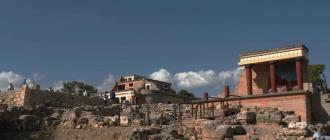Informatics lesson in grade 8 (IG Semakin)
Place of work, Position: MOU "SOSH №27" of Syktyvkar, Teacher of Informatics Petrov Vasily Yuryevich.
Region: Komi Republic
Education Level: Basic General Education
Class (s): Grade 8
Subject (s): Informatics
The purpose of the lesson: to get acquainted with the concept of database, their types, organization.
Type of lesson: lesson studying a new material.
Pupils in the classroom: 10-20
Equipment used: computer, projector, slides.
Abstract lesson.
Topic: concept of information system, database, DBMS.
The purpose of the lesson: get acquainted with the types of databases and the data organization in them ..
Tasks:
1. Educational
Teach distinguishing databases by types;
Give the table reading techniques as relational databases.
2. Developing
Develop interest in structuring information;
Develop analytical thinking of children, their creative abilities, the ability to work with a different kind of information.
3. Educational
Educate hard work, preferabity, patience.
4. Personal oriented
Creating situations of communication in a lesson that allows each student to take the initiative, independence.
Equipment: computer, projector.
Software: Microsoft Office Power Point Presentation.
Plan:
Organizing time.
Analysis of the studied material.
Message themes and objectives of the lesson.
Conversation.
Outcome.
During the classes
Organizing time.
Prepared notebooks, handles, drew attention to the board.
Analysis of the studied material.
Before proceeding to the topic of the lesson, let's remember that we studied on previous lessons. Answer: Information models: tabular, graphic, etc. We analyzed them independently, without the use of computer equipment. Modern means allow processing data on a computer in large volumes.
Message themes and objectives of the lesson.
Let's post the databases. (Slide number 1)
Main conversation
Let's talk about structuring information, its collection and storage (Slide No. 2).
Processing information using computer equipment and will be called an information system. (Slide number 3).
Let the concept of the database, taking into account the available information (Slide No. 4).
Let's classify databases by types. We include students to work by direct communication (slide number 5). Discussion.
We study in detail each database type (slides number 6,7,8).
We get acquainted with relational databases, remember the table information models (Slide No. 9).
Apply to the key of relational bases. We are talking about the uniqueness of each record (slide number 10).
Remember the types of information on the form of the submission and talk about what data we can store in databases (Slide No. 11).
7. The results of the lesson. (Slide 19,20)
Our lesson comes to an end. You worked well so today! What do you remember? What did you learn to?
List of sources used
Informatics: textbook for grade 8 / I.G. Semaakin, L.A.
- Acquaintance with databases
PPTX / 2.43 MBLental, S.V. Rusakova, L.V. Shestakova. - 2nd ed., Act. - M.: Binin. Laboratory of Knowledge, 2014. - 176 p. : IL.
The concept of DBMS -
Database (database) - Database (dB) This is a combination, in a certain way
organized information on some
topic.
For instance:
Book Fund Database Library;
Database of personnel composition of the institution;
The database of legislation in the field
criminal law;
Database of modern pop song.
Classification of database.
The database is classified by different signs:By the nature of the stored information of the database
are divided into factory and
documentary;
According to the data storage method of the database there
centralized and distributed;
According to the structure of the BD organization
classified for relational,
Network and hierarchical.
In factographic database
contains brief information aboutDescribed objects presented with
Strictly defined format.
Examples:
1. In the library database about each book
The following information is stored: year
Edition, author, title, etc.
2. In the database of the personnel of the personnel are stored
Employees: FULL NAME, BIRTHDAY AND
etc.
Documentary database
contains extensive information itselfVarious type: Text, Graphic,
Sound, multimedia.
Examples:
1. In the database of laws - the texts of the laws themselves,
2. In the database of the pop song - texts and notes
Songs, biography of authors, information about
poets, composers and performers,
Sound and video clips.
Information system
- This is the totality of the database and the whole complexhardware and software for her
storage, change and search
information for interaction with
user.
Examples:
1. Ticket sale systems on
Passenger trains and aircraft.
2. WWW is a global information
system.
Database (database)
- This is a structured aggregateinterrelated data within
some subject area
Designed for long
storage in external memory
Computer and constant
Applications. Database storage can be used
to one computer, such database
called centralized.
If different parts of one database
stored on a variety of computers,
combined with a network, then
Such a database is called
Distributed database.
Hierarchical called database,
in which information is orderedas follows: one element
records are considered the main one
Subordinates.
Examples: File system Family tree
Network called database,
in which to vertical connectionsHorizontal connections are added.
Relational database
- Databases with tabular shapeInformation organization.
Relational database consists of one or
Several interconnected
Two-dimensional tables.
Examples:
In the relational (table) database, the string is called a record, and the column is a field.
Fields are different characteristics.(Sometimes attributes) of the object.
Values \u200b\u200bof fields in one line
belong to one object.
Different fields are distinguished by the names.
Example 1. Organization of information in a one-bit database "Repertoire of cinema for a week."
Cinemafilm
Russia
Adventure 11.00
Buratino
Titanic
13.00
3.00
Russia
Russia
Titanic
Star
landing
17.00
21.00
20.00
15.00
Peace
Wait for it!
11.00
3.00
Peace
Titanic
13.00
15.00
Peace
Thief
17.00
10.00
Russia
time
Cost
15.00
Primary (main) key database
- this is a field or group of fields, withusing which you can definitely
Identify recording. Value
the primary key should not
Repeat from different records. AT
The example above in
as the primary database key
Take a group of fields
cinema + time.
Type of field
defines many valueswhich can take this
Field in various records.
In relational databases
Four main types are used
Fields: numeric, symbol,
date, logical Numeric type have fields whose values
can only be numbers. Numbers can be
whole and real.
The symbol type has fields in which will be
Stored symbolic sequences
(words, texts, codes, etc.).
The type "date" has fields containing
Calendar dates in various shapes.
The logical type matches the field that
can take only two meanings:
"Yes" - "no" or "truth" - "lie".
Example 2. Describe the structure of the database "Repertoire of cinemas for a week."
Describe the structure - it means to specify allTable fields and their characteristics.
Name of the field
a type
width
cinema
Symbol
15
film
Symbol
25
time
numerical
5
2
Cost
numerical
5
2
Kol-V.
decimal
Signs
Example 3. An fragment of the relational database is given: specify the main key; Describe field characteristics.
Date numberDeparture flight
2156
A type
Price
Airplane ticket
10/23/08 TU-154
4564.50
Availability
Tickets
Yes
Main key: flight number + departure date. Field descriptions:
name of the fielda type
width
Flight number
numerical
4
departure date
date
Type of aircraft
Symbol
10
Ticket price
numerical
5
Availability
Tickets
logical
Number of
decimal
Signs
2
Example 4. Convert to tabular form hierarchical structure shown in Fig.
Example 4. Convert to table form hierarchicalThe structure shown in fig.
Department
Faculty
University
General physics
Physical
PGU
Theoretical physics
Physical
PGU
Organic chemistry
Chemical
PGU
inorganic chemistry
Chemical
PGU
Botany
Biological
PGU
Zoology
biological
PGU
Task number 1.
TransformThe following
Information K.
tabular
Having determined the name of the table and
Name of each field:
Olya, Peter, 13, singing, 14,
Basketball, Vasya, Katya,
13, hockey, basketball,
Football, 15,11, Kolya, 11,
Dancing, Seryozha.
Table name: Employment in
Circles
Name
Age Circle
Olya
13
Singing
Petya
14
Basketball
Vasya
13
Hockey
Kate
15
Basketball
Kolya
11
Football
Seryozha 11.
dancing
Self perform:
1.The database table "Patient" contains
Fields: Surname, Name, Patronymic, Date
birth, site number, address,
The presence of chronic diseases, date
The last visit to the doctor.
Determine the type and width of each
Slide 1.
Clade 2.
 The database serve to store and search for a large amount of information. Examples of databases: a notebook, dictionaries, reference books, encyclopedias. Database - Structural Information Model Database (DB) - a set of stored interconnected data organized according to a certain rules of Wheel J. V.
The database serve to store and search for a large amount of information. Examples of databases: a notebook, dictionaries, reference books, encyclopedias. Database - Structural Information Model Database (DB) - a set of stored interconnected data organized according to a certain rules of Wheel J. V.
Slide 3.
 According to the nature of the stored data information, the database is divided into factual databases contained brief summary of the described objects presented in a construction specified format. For example, the library database about each book is kept bibliographic information: the year of publication, author, name, etc. The documentary database contains documents (information) of the most different type: text, graphic, sound, multimedia (for example , various sprapers, dictionaries) Wheel J. V.
According to the nature of the stored data information, the database is divided into factual databases contained brief summary of the described objects presented in a construction specified format. For example, the library database about each book is kept bibliographic information: the year of publication, author, name, etc. The documentary database contains documents (information) of the most different type: text, graphic, sound, multimedia (for example , various sprapers, dictionaries) Wheel J. V.
Slide 4.
 Examples of databases: BD Book Fund Library; Database of personnel composition of the institution. Bd legislative acts in the field of criminal law; BD of modern rock music. Factographic documentary database includes only information (BD - "Information Warehouse") Kolovova J. V.
Examples of databases: BD Book Fund Library; Database of personnel composition of the institution. Bd legislative acts in the field of criminal law; BD of modern rock music. Factographic documentary database includes only information (BD - "Information Warehouse") Kolovova J. V.
Slide 5.
 By the database storage method is divided into a centralized database - the database is stored on the same computer distributed database - various parts of the same database are stored on the multist of computers, combined with each other. Example: information on the Internet network, combined web WWW Wheels
By the database storage method is divided into a centralized database - the database is stored on the same computer distributed database - various parts of the same database are stored on the multist of computers, combined with each other. Example: information on the Internet network, combined web WWW Wheels
Slide 6.
 According to the structure of the organization's organization, they are divided into relational unregulated hierarchical network relational (from the English word Relation - attitude) is called a database containing information organized in the form of direct tables related to each other. Such a table is called the attitude of the hierarchical called the database in which the information is ordered as follows: one element of the record is considered the main, the rest are subordinates. The hierarchical database form the file system on the disk, the genealogical tree of the network is called the database, in which horizontal connections are added to vertical hierarchical bonds. Wheel J. V.
According to the structure of the organization's organization, they are divided into relational unregulated hierarchical network relational (from the English word Relation - attitude) is called a database containing information organized in the form of direct tables related to each other. Such a table is called the attitude of the hierarchical called the database in which the information is ordered as follows: one element of the record is considered the main, the rest are subordinates. The hierarchical database form the file system on the disk, the genealogical tree of the network is called the database, in which horizontal connections are added to vertical hierarchical bonds. Wheel J. V.
Slide 7.
 DB structure Each table must have its name. Recording is a table string. The field is a table column. Table - information model of the real system. The recording contains information about one specific object. The field contains certain characteristics of objects. The main element of the database - the record of Wheel J. V.
DB structure Each table must have its name. Recording is a table string. The field is a table column. Table - information model of the real system. The recording contains information about one specific object. The field contains certain characteristics of objects. The main element of the database - the record of Wheel J. V.
Slide 8.
 Table Name Field Recording Main key is a field or a set of fields that uniquely defines an entry in the Table Table J. V.
Table Name Field Recording Main key is a field or a set of fields that uniquely defines an entry in the Table Table J. V.

Municipal Autonomous Secondary Institution
"Mias Central Secondary School No. 16"
Presentation
on computer science for grade 9
on the topic:
Computer Science Teacher, 1st category
Shavaleeva Svetlana Alekseevna
Miass

DATABASE.

INFORMATION SYSTEM - This is a set of database and the whole complex of hardware and software to store it, change and search for information to interact with the user
Database Management System (DBMS) Software designed to work with databases
Database (database)

Databases and Information Systems
Database (database)
An organized set of data intended for long-term storage in the external memory of the computer and continuous use
Factographic
Brief information about objects in a strictly defined format
Documentary
Distributed database
Documents in various format
Storing different parts of one database on a variety of computers, combined with a network.
- text information
- graphic objects
- sound information
- multimedia objects
- . . . . . . . . . . . . . . . . . .
- library catalog
- personnel database
- reference card file
- . . . . . . . . . . . . . . . .


Hierarchical model
In the hierarchical model, the structure of the information has the shape of a tree. At the highest (first) level there is only one vertex, which is called the root. This vertex has a connection with the tops of the second level, the tops of the second level have connections only with the tops of the third level, etc.

- In the network model main structure information presentations has a network form In which each vertex may have a connection with any other.

- In relational model information is presented in the form of a table. . Rows of the table are records, and columns are the same fields.

Database Management Systems
- DBMS - Applied program designed to work with the database.
DBMS - software tools that provide access to information stored in the database, its maintenance and processing.
- Examples of DBMS:
- Kbase, FoxPro, Vista, RBDMSX, Access.
- Kbase
- FoxPro,
- Vista
- RBDMSX,
- Access.

DATA TYPES
1) text - The values \u200b\u200bof the text given is a set of alphanumeric characters. Text data length does not exceed 255 characters. Default, Microsoft Access. Specifies the length of 50 characters. The task of the length of the text field means that when you try to enter into this field, longer text extensions will be ignored. If the text field contains numeric data, then these data are perceived as text, and cannot participate in mathematical operations.
Text data type
Text data type

DATA TYPES
2) The counter is used to automatically number the records.
Data type "Counter"

DATA TYPES
3) Numerical - Used for data (integers and fractional) participating in calculations.
Numeric data can be in any of the following formats:
Value
Description
Byte
Numbers from 0 to 255 (without fractional part)
Whole
Fraction
Long whole
Numbers from -32768 to 32767 (without fractional part)
Absent
The size
1 byte
(Default value). Numbers from -2147483648 to 2147483647
(without fractional part)
Absent
Floating point (4 bytes)
Floating Point (8 bytes)
Numbers OT
-3.402823 * to 3.402823 *
Absent
2 byte
4 byte
Numbers OT
-1.79769313486232 * to 1.79769313486232 *
Replication code
4 byte
Unique Global Identifier (GUID)
8 bytes
Undefined
16 bytes

DATA TYPES
4) Date / Time - Applied to store time or date. It is possible to make calculations with data (calculate the time interval between individual dates).
Data type "DATE"

DATA TYPES
5) cash - Almost the same as the numeric type, but with a fixed number of signs after a semicolons in the form of a decimal fraction and with a monetary unit sign.

DATA TYPES
6) Logic fields - Used to store data that can take one of two possible values: True / Lying , Yes / No or On off . In this value True , Yes and Incl True. and meanings Lying , No and OFF Equivalent to logical meaning False .

DATA TYPES
7) OLE object fields - Allows you to store in the image tables and other binary data (for example, a spreadsheet Microsoft. Excel , Document Microsoft Word. , drawing, sound recording).

DATA TYPES

DATA TYPES
9) Field Memo. - Text fields of arbitrary length may contain the same data types as simple text fields. The difference between these fields is that the size of the field Memo. 255 symbols are not limited, and may contain up to 65535 characters.

DATA TYPES
10) Data Type Wizard - Designed to create a field in which the selection of values \u200b\u200bfrom the drop-down list containing a set of permanent values \u200b\u200bor values \u200b\u200bfrom another table is proposed.

Types of fields in relational databases
Type of field Defines many values \u200b\u200bthat can receive this field in various records.
numerical
symbol
date Time
logical
These fields are designed to store calendar dates and day time data
Date: "Day / month / year"
Time watch : Minutes »
The field value can only be a number
These fields are stored symbolic sequences (words, texts, etc.).
Database "Optional"
Database "Time Accounting Time"
Surname, name
Ivanov Petya
Petrov Vanya
Time accounting
Sidorov Vitya
Time spent
numerical
symbol
logical

ACCESS 2007 objects
Tables - Basic database objects.
Inquiries - These are special structures designed to process database data.
Forms - These are objects with which new data is introduced into the database or view available.
Reports - These are the form "on the contrary," with their help data is issued to the printer in a convenient and visual form.
Macros - this is macrocomands.
Modules - These are software procedures written in Visual Basic.
Modes of work with Access 2007
There are two different modes in working with any database: design - With the help of the designer
and operational (Custom) - Using the Master.






